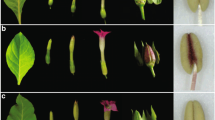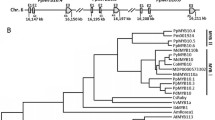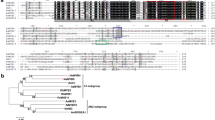Abstract
Key message
The Md - MYB10 R6 gene from apple is capable of self-regulating in heterologous host species and enhancing anthocyanin pigmentation, but the activity of MYB10 is dependent on endogenous protein partners.
Abstract
Coloured foliage due to anthocyanin pigments (bronze/red/black) is an attractive trait that is often lacking in many bedding, ornamental and horticultural plants. Apples (Malus × domestica) containing an allelic variant of the anthocyanin regulator, Md-MYB10 R6 , are highly pigmented throughout the plant, due to autoregulation by MYB10 upon its own promoter. We investigated whether Md-MYB10 R6 from apple is capable of functioning within the heterologous host Petunia hybrida to generate plants with novel pigmentation patterns. The Md-MYB10 R6 transgene (MYB10–R6 pro :MYB10:MYB10 term ) activated anthocyanin synthesis when transiently expressed in Antirrhinum rosea dorsea petals and petunia leaf discs. Stable transgenic petunias containing Md-MYB10 R6 lacked foliar pigmentation but had coloured flowers, complementing the an2 phenotype of ‘Mitchell’ petunia. The absence of foliar pigmentation was due to the failure of the Md-MYB10 R6 gene to self-activate in vegetative tissues, suggesting that additional protein partners are required for Md-MYB10 to activate target genes in this heterologous system. In petunia flowers, where endogenous components including MYB-bHLH-WDR (MBW) proteins were present, expression of the Md-MYB10 R6 promoter was initiated, allowing auto-regulation to occur and activating anthocyanin production. Md-MYB10 is capable of operating within the petunia MBW gene regulation network that controls the expression of the anthocyanin biosynthesis genes, AN1 (bHLH) and MYBx (R3-MYB repressor) in petals.



Similar content being viewed by others
Abbreviations
- MBW:
-
MYB-bHLH-WDR
- bHLH:
-
Basic-helix-loop-helix
- WDR:
-
WD-repeat
References
Albert NW, Lewis DH, Zhang H, Irving LJ, Jameson PE, Davies KM (2009) Light-induced vegetative anthocyanin pigmentation in Petunia. J Exp Bot 60:2191–2202
Albert NW, Lewis DH, Zhang H, Schwinn KE, Jameson PE, Davies KM (2011) Members of an R2R3-MYB transcription factor family in Petunia are developmentally and environmentally regulated to control complex floral and vegetative pigmentation patterning. Plant J 65:771–784
Albert NW, Davies KM, Lewis DH, Zhang H, Montefiori M, Brendolise C, Boase MR, Ngo H, Jameson PE, Schwinn KE (2014a) A conserved network of transcriptional activators and repressors regulates anthocyanin pigmentation in eudicots. Plant Cell 26:962–980
Albert NW, Davies KM, Schwinn KE (2014b) Gene regulation networks generate diverse pigmentation patterns in plants. Plant Signal Behav 9:e29526
Albert NW, Griffiths AG, Cousins GR, Verry IM, Williams WM (2015) Anthocyanin leaf markings are regulated by a family of R2R3-MYB genes in the genus Trifolium. New Phytol 205:882–893
Baudry A, Caboche M, Lepiniec L (2006) TT8 controls its own expression in a feedback regulation involving TTG1 and homologous MYB and bHLH factors, allowing a strong and cell-specific accumulation of flavonoids in Arabidopsis thaliana. Plant J 46:768–779
Borevitz JO, Xia YJ, Blount J, Dixon RA, Lamb C (2000) Activation tagging identifies a conserved MYB regulator of phenylpropanoid biosynthesis. Plant Cell 12:2383–2393
Butelli E, Licciardello C, Zhang Y, Liu J, Mackay S, Bailey P, Reforgiato-Recupero G, Martin C (2012) Retrotransposons control fruit-specific, cold-dependent accumulation of anthocyanins in blood oranges. Plant Cell 24:1242–1255
Cheynier V, Comte G, Davies KM, Lattanzio V, Martens S (2013) Plant phenolics: recent advances on their biosynthesis, genetics, and ecophysiology. Plant Physiol Biochem 72:1–20
Chiu LW, Zhou X, Burke S, Wu X, Prior RL, Li L (2010) The purple cauliflower arises from activation of a MYB transcription factor. Plant Physiol 154:1470–1480
Cone KC, Cocciolone SM, Moehlenkamp CA, Weber T, Drummond BJ, Tagliani LA, Bowen BA, Perrot GH (1993) Role of the regulatory gene pl in the photocontrol of maize anthocyanin pigmentation. Plant Cell 5:1807–1816
Conner AJ, Albert NW, Deroles SC (2009) Transformation and regeneration of petunia. In: Gerats T, Strommer J (eds) Petunia: Evolutionary, Developmental and Physiological Genetics, 2nd edn. Springer, New York, pp 395–409
Davies KM, Espley RV (2013) Opportunities and challenges for metabolic engineering of secondary metabolite pathways for improved human health characters in fruit and vegetable crops. N Z J Crop Hortic Sci 41:154–177
Davies KM, Schwinn KE (2003) Transcriptional regulation of secondary metabolism. Funct Plant Biol 30:913–925
Davies KM, Albert NW, Schwinn KE (2012) From landing lights to mimicry: the molecular regulation of flower colouration and mechanisms for pigmentation patterning. Funct Plant Biol 39:619–638
Dixon RA, Paiva NL (1995) Stress-induced phenylpropanoid metabolism. Plant Cell 7:1085–1097
Dubos C, Gourrierec JL, Baudry A, Huep G, Lanet E, Debeaujon I, Routaboul J-M, Alboresi A, Weisshaar B, Lepiniec L (2008) MYBL2 is a new regulator of flavonoid biosynthesis in Arabidopsis thaliana. Plant Journal 55:940–953
Espley RV, Hellens RP, Putterill J, Stevenson DE, Kutty-Amma S, Allan AC (2006) Red colouration in apple fruit is due to the activity of the MYB transcription factor, MdMYB10. Plant J 49:414–427
Espley RV, Brendolise C, Chagne D, Kutty-Amma S, Green S, Volz R, Putterill J, Schouten HJ, Gardiner SE, Hellens RP, Allan AC (2009) Multiple repeats of a promoter segment causes transcription factor autoregulation in red apples. Plant Cell 21:168–183
Gamborg OL, Miller RA, Ojima K (1968) Nutrient requirements of suspension cultures of soybean root cells. Exp Cell Res 50:151–158
Gong ZZ, Yamazaki M, Saito K (1999) A light-inducible Myb-like gene that is specifically expressed in red Perilla frutescens and presumably acts as a determining factor of the anthocyanin forma. Mol Gen Genet 262:65–72
Gonzalez A, Zhao M, Leavitt JM, Lloyd AM (2008) Regulation of the anthocyanin biosynthetic pathway by the TTG1/bHLH/Myb transcriptional complex in Arabidopsis seedlings. Plant J 53:814–827
Hernandez JM, Feller A, Morohashi K, Frame K, Grotewold E (2007) The basic helix-loop-helix domain of maize R links transcriptional regulation and histone modifications by recruitment of an EMSY-related factor. Proc Natl Acad Sci USA 104:17222–17227
Hunter DA, Steele BC, Reid MS (2002) Identification of genes associated with perianth senescence in Daffodil (Narcissus pseudonarcissus L. ‘Dutch Master’). Plant Sci 163:13–21
Koes R, Verweij W, Quattrocchio F (2005) Flavonoids: a colorful model for the regulation and evolution of biochemical pathways. Trends Plant Sci 10:236–242
Kong Q, Pattanaik S, Feller A, Werkman JR, Chai C, Wang Y, Grotewold E, Yuan L (2012) Regulatory switch enforced by basic helix-loop-helix and ACT-domain mediated dimerizations of the maize transcription factor R. Proc Natl Acad Sci USA 109:E2091–E2097
Kroon A (2004) Transcription regulation of the anthocyanin pathway in Petunia hybrida. Ph.D. Thesis, Vrije Universiteit, Amsterdam
Martin C, Gerats T (1993) Control of pigment biosynthesis genes during petal development. Plant Cell 5:1253–1264
Martin C, Butelli E, Petroni K, Tonelli C (2011) How can research on plants contribute to promoting human health? Plant Cell 23:1685–1699
Matsui K, Umemura Y, Ohme-Takagi M (2008) AtMYBL2, a protein with a single MYB domain, acts as a negative regulator of anthocyanin biosynthesis in Arabidopsis. Plant J 55:954–967
Murashige T, Skoog F (1962) A revised medium for rapid growth and bioassays with tobacco tissue cultures. Physiol Plant 15:743–747
Peel GJ, Pang Y, Modolo LV, Dixon RA (2009) The LAP1 MYB transcription factor orchestrates anthocyanidin biosynthesis and glycosylation in Medicago. Plant J 59:136–149
Pilu R, Piazza P, Petroni K, Ronchi A, Martin C, Tonelli C (2003) pl-bol3, a complex allele of the anthocyanin regulatory pl1 locus that arose in a naturally occurring maize population. Plant J 36:510–521
Quattrocchio F, Wing JF, van der Woude K, Mol JNM, Koes R (1998) Analysis of bHLH and MYB domain proteins: species-specific regulatory differences are caused by divergent evolution of target anthocyanin genes. Plant J 13:475–488
Ramsay NA, Glover BJ (2005) MYB-bHLH-WD40 protein complex and the evolution of cellular diversity. Trends Plant Sci 10:63–70
Schwinn K, Venail J, Shang Y, Mackay S, Alm V, Butelli E, Oyama R, Bailey P, Davies K, Martin C (2006) A small family of MYB-regulatory genes controls floral pigmentation intensity and patterning in the genus Antirrhinum. Plant Cell 18:831–851
Schwinn KE, Boase MR, Bradley JM, Lewis DH, Deroles SC, Martin CR, Davies KM (2014) MYB and bHLH transcription factor transgenes increase anthocyanin pigmentation in petunia and lisianthus plants, and the petunia phenotypes are strongly enhanced under field conditions. Front Plant Sci 5:603
Spelt C, Quattrocchio F, Mol JNM, Koes R (2000) Anthocyanin1 of petunia encodes a basic helix-loop-helix protein that directly activates transcription of structural anthocyanin genes. Plant Cell 12:1619–1631
Yuan YW, Sagawa JM, Frost L, Vela JP, Bradshaw HD Jr (2014) Transcriptional control of floral anthocyanin pigmentation in monkeyflowers (Mimulus). New Phytol 204:1013–1027
Zhang Y, Butelli E, Martin C (2014) Engineering anthocyanin biosynthesis in plants. Curr Opin Plant Biol 19:81–90
Acknowledgments
We thank David Lewis, Huaibi Zhang and Andrew Allan for thoughtful discussions and critique; Andrew Mullan and Belinda Diepenheim for making media; Ian King and Julie Ryan for excellent plant care; Tony Corbett for photography; Andrew McLaughlan for statistics assistance.
Author information
Authors and Affiliations
Corresponding author
Ethics declarations
Funding
This work was supported by Plant & Food Research’s ‘Blue Skies’ fund.
Conflict of interest
CB, RPH and RVE are inventors on a patent family (based on WO2009139649) held by The New Zealand Institute for Plant & Food Research Ltd., on the use of the MYB10 gene and promoter for commercial activities. The authors declare that they have no other conflicts of interest.
Additional information
Communicated by Q. Zhao.
Rights and permissions
About this article
Cite this article
Boase, M.R., Brendolise, C., Wang, L. et al. Failure to launch: the self-regulating Md-MYB10 R6 gene from apple is active in flowers but not leaves of Petunia . Plant Cell Rep 34, 1817–1823 (2015). https://doi.org/10.1007/s00299-015-1827-4
Received:
Revised:
Accepted:
Published:
Issue Date:
DOI: https://doi.org/10.1007/s00299-015-1827-4




